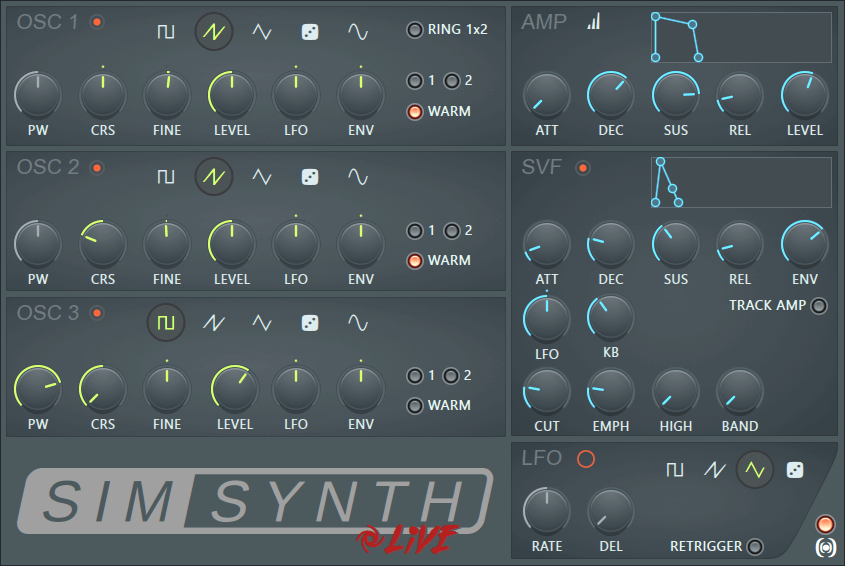INSTRUMENTS / GENERATORS
SimSynth Live

SimSynth Live is modeled after the classic analogue synthesizers of the 80's and is capable of producing a wide range of instruments and effects: from strings and pads to deep bass lines.

The sound is created by three oscillators, filtered by a SVF section (State Variable Filter) and amplified by an ADSR envelope. The unit includes a programmable LFO section that can control some of the parameters in the oscillator and SVF sections. Finally you can filter the sound with a chorus effect to widen the stereo panorama of the patch.
Parameters
Oscillators Section (OSC1, OSC2, OSC3)
- Oscillator ON/OFF switch - Each oscillator has a checkbox on its left that can be used to turn it on/off. An orange light indicates the oscillator is turned on.
- Oscillator Waveshape selector - The selector is located at the top of each oscillator. You can use it to select the wave shape used for synthesis: Pulse/Square – This produces a bright tone sounds. The pulse width can be adjusted using the PW knob (and can also achieve square oscillator shape); Saw – Produces bright tone sounds yet with different harmonics than Pulse/Square; Triangle – Produces dark tone sounds; Noise – Produces random white noise. The frequency range of the noise can be adjusted using the CRS knob where zero is white noise (full spectrum); Sine – This produces a very dark and pure tone. The sine can be varied from standard to the 4th power using the PW knob.
- Pulse Width wheel (PW) – Adjusts the pulse width of the Pulse wave shape. This varies the harmonic content of the oscillator (technically it varies it from odd harmonics to all harmonics). It also affects the Sine wave shape - from standard sine to 4th power of sine.
- Frequency wheel (CRS) – Offsets the frequency of the oscillator in semitones. Has a two octave range, from –12 to +12.
- Fine Frequency (FINE) – Offsets the frequency of the oscillator in cents, (1/100-th’s of a semitone). Has a two semitone range, from –100 to +100.
- Level wheel (LVL) – Sets the output level (volume) of the oscillator from 0 to 100%.
- LFO Modulation wheel (LFO) – Specifies the amount of frequency modulation from the LFO unit. Has a two octave range, from –100% to +100%. Note that in order for the LFO to modulate around a tuned frequency, the CRS and/or FINE knobs must be adjusted to compensate for the variation.
- Envelope Modulation wheel (ENV) - Specifies the amount of frequency modulation from the Amplitude Envelope. Has a two octave range, from –100% to +100%.
- Mix One Octave switch (1) – Mixes additional wave in the oscillator (one octave higher). Adds an octave to the oscillator. Best used with the sine and triangular wave shapes.
- Mix Two Octaves switch (2) – Mixes additional wave in the oscillator (two octaves higher). Best used with the sine wave shape.
- Warm Oscillator switch (WARM) – Softens the oscillator sound by mixing a second wave with slightly detuned frequency (without variation).
- Ring Modulation switch (Ring 1x2) – Ring modulates Oscillator 1 by Oscillator 2. This produces a "harsh" sound that was expensive with the older analogue synths.
Filter Section (SVF)
- Filter Envelope Attack wheel (ATT) - The amount of time required for the envelope to go from zero to full when a new note is played.
- Filter Envelope Decay wheel (DEC) – The amount of time required for the envelope to fall from full to the sustain level after the attack.
- Filter Envelope Sustain wheel (SUS) – The level at which the filter envelope will sustain as long as a note is held.
- Filter Envelope Release wheel (REL) – The amount of time required for the envelope to fall from the sustain level to zero after the note is released, or through being held.
- Envelope to Filter wheel (ENV) - The amount of modulation of the filter envelope over the filter cutoff value (negative or positive). This amount is added to the existing cutoff value.
- LFO Modulation wheel (LFO) - The amount of modulation of the LFO over the cutoff value (negative or positive). This amount is added to the existing cutoff value. Important: You must turn on the LFO unit first for this knob to have any affect.
- KB to Cutoff wheel (KB) – The amount of modulation of the note's pitch over the cutoff values.
- Track Amp switch (TRACK AMP) - This switch disables the filter envelope, and the Amplitude Envelope is used instead. The ENV wheel then controls the modulation of the Amplitude Envelope over the cutoff level. This makes editing easier when creating presets with identical filter and amp envelopes.
- Cut Off Frequency wheel (CUT) – The base cutoff frequency of the filter, from 0% to 100%.
- Filter Emphasis wheel (EMPH) – Also called resonance and Q. Emphasizes the frequencies near the cutoff. A little emphasis is useful for general purpose synthesis. A lot of emphasis sounds highly electronic and is useful for techno or special effects (together with cutoff frequency variations).
- High Pass Frequency wheel (HIGH) – Sets the high pass frequency of the filter. Note that this knob reduces low pass output as high pass output is increased. Set to 50% to produce a notch filter.
- Band Pass Frequency wheel (BAND) – Sets the band pass frequency of the filter. Note that this knob reduces low pass (or high pass as specified by the high knob), as band pass output is increased.
Amplitude Envelope (AMP)
- Amplitude Envelope Attack wheel (ATT) - The amount of time required for the envelope to go from zero to full when a new note is played.
- Amplitude Envelope Decay wheel (DEC) – The amount of time required for the envelope to fall from full to the sustain level after the attack.
- Amplitude Envelope Sustain wheel (SUS) – The level at which the filter envelope will sustain as long as a note is held.
- Amplitude Envelope Release wheel (REL) – The amount of time required for the envelope to fall from the sustain level to zero after the note is released, or through being held.
- Volume wheel (LVL) – The overall volume of the audio output of SimSynth.
Low Frequency Oscillator Section (LFO)
- LFO Waveshape selector - The selector is placed on the top of the LFO section. You can use it to select the shape used for oscillation: Square – Alternates between the max and min values; Saw – Falls gradually down to the min value then switches to max again; Triangle – Alternates gradually between the max and min values; Noise – Produces random values.
- LFO Rate wheel (RATE) - The LFO speed.
- LFO Delay wheel (DEL) - The amount of time required for the LFO to take affect after a note starts. It can be seen as fade in or attack time for the LFO.
- LFO retrigger switch (RETRIGGER) - When selected, the LFO starts at zero when a note is played. Also, the delay (see above) begins with each note. When not selected, the LFO cycles continually for all notes.
Chorus Switch
- Chorus switch (CHORUS) - When turned on, applies a chorus effect to sound. The chorus widens the stereo output by slightly delaying and modulating the frequency of the sound. It usually adds a nice, stereo touch to any preset - however, it can cause a side effect called "phase cancellation" which might not be desired.
- Phase cancellation might cause problems with bass sounds, especially if they get mixed to mono and played through a subwoofer at some point).
Plugin Credits: David Billen (engine), Frederic Vanmol (conversion), Didier Dambrin (interface)